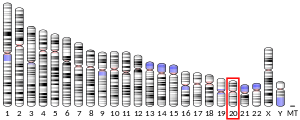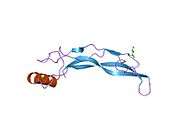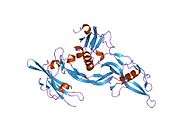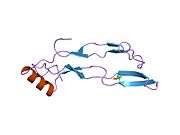Bone morphogenetic protein 2
Bone morphogenetic protein 2 or BMP-2 belongs to the TGF-β superfamily of proteins.[5]
Function
BMP-2 like other bone morphogenetic proteins,[6] plays an important role in the development of bone and cartilage. It is involved in the hedgehog pathway, TGF beta signaling pathway, and in cytokine-cytokine receptor interaction. It is also involved in cardiac cell differentiation and epithelial to mesenchymal transition.
Like many other proteins from the BMP family, BMP-2 has been demonstrated to potently induce osteoblast differentiation in a variety of cell types.[7]
BMP-2 may be involved in white adipogenesis[8][9] and may have metabolic effects.[8][9]
Clinical use and complications
Bone morphogenetic protein 2 is shown to stimulate the production of bone.[14][15] Recombinant human protein (rhBMP-2) is currently available for orthopaedic usage in the United States.[16] Implantation of BMP-2 is performed using a variety of biomaterial carriers ("metals, ceramics, polymers, and composites"[17]) and delivery systems ("hydrogel, microsphere, nanoparticles, and fibers"[17]). While used primarily in orthopedic procedures such as spinal fusion,[18][19] BMP-2 has also found its way into the field of dentistry.[20][21][22]
The use of dual tapered threaded fusion cages and recombinant human bone morphogenetic protein-2 on an absorbable collagen sponge obtained and maintained intervertebral spinal fusion, improved clinical outcomes, and reduced pain after anterior lumbar interbody arthrodesis in patients with degenerative lumbar disc disease.[18] As an adjuvant to allograft bone or as a replacement for harvested autograft, bone morphogenetic proteins (BMPs) appear to improve fusion rates after spinal arthrodesis in both animal models and humans, while reducing the donor-site morbidity previously associated with such procedures.[19]
A study published in 2011 noted "reports of frequent and occasionally catastrophic complications associated with use of [BMP-2] in spinal fusion surgeries", with a level of risk far in excess of estimates reported in earlier studies.[23][24] An additional review by Agrawal and Sinha of BMP-2 and its common delivery systems in early 2016 showed how "problems like ectopic growth, lesser protein delivery, [and] inactivation of the protein" reveal a further need "to modify the available carrier systems as well as explore other biomaterials with desired properties."[17]
References
- GRCh38: Ensembl release 89: ENSG00000125845 - Ensembl, May 2017
- GRCm38: Ensembl release 89: ENSMUSG00000027358 - Ensembl, May 2017
- "Human PubMed Reference:". National Center for Biotechnology Information, U.S. National Library of Medicine.
- "Mouse PubMed Reference:". National Center for Biotechnology Information, U.S. National Library of Medicine.
- Sampath TK, Coughlin JE, Whetstone RM, Banach D, Corbett C, Ridge RJ, Ozkaynak E, Oppermann H, Rueger DC (August 1990). "Bovine osteogenic protein is composed of dimers of OP-1 and BMP-2A, two members of the transforming growth factor-beta superfamily". J. Biol. Chem. 265 (22): 13198–205. PMID 2376592.
- Chen D, Zhao M, Mundy GR (December 2004). "Bone morphogenetic proteins". Growth Factors. 22 (4): 233–41. doi:10.1080/08977190412331279890. PMID 15621726.
- Marie PJ, Debiais F, Haÿ E (2002). "Regulation of human cranial osteoblast phenotype by FGF-2, FGFR-2 and BMP-2 signaling". Histol. Histopathol. 17 (3): 877–85. doi:10.14670/HH-17.877. PMID 12168799.
- Jin W, Takagi T, Kanesashi SN, Kurahashi T, Nomura T, Harada J, Ishii S (April 2006). "Schnurri-2 controls BMP-dependent adipogenesis via interaction with Smad proteins". Developmental Cell. 10 (4): 461–71. doi:10.1016/j.devcel.2006.02.016. PMID 16580992.
- Blázquez-Medela AM, Jumabay M, Boström KI (January 2019). "Beyond the bone: Bone morphogenetic protein signaling in adipose tissue". Obesity Reviews. 20 (5): 648–658. doi:10.1111/obr.12822. PMC 6447448. PMID 30609449.
- Nickel J, Dreyer MK, Kirsch T, Sebald W (2001). "The crystal structure of the BMP-2:BMPR-IA complex and the generation of BMP-2 antagonists". J Bone Joint Surg Am. 83-A Suppl 1 (Pt 1): S7–14. PMID 11263668.
- Kirsch T, Nickel J, Sebald W (February 2000). "Isolation of recombinant BMP receptor IA ectodomain and its 2:1 complex with BMP-2". FEBS Lett. 468 (2–3): 215–9. doi:10.1016/S0014-5793(00)01214-X. PMID 10692589.
- Kirsch T, Nickel J, Sebald W (July 2000). "BMP-2 antagonists emerge from alterations in the low-affinity binding epitope for receptor BMPR-II". EMBO J. 19 (13): 3314–24. doi:10.1093/emboj/19.13.3314. PMC 313944. PMID 10880444.
- Gilboa L, Nohe A, Geissendörfer T, Sebald W, Henis YI, Knaus P (March 2000). "Bone morphogenetic protein receptor complexes on the surface of live cells: a new oligomerization mode for serine/threonine kinase receptors". Mol. Biol. Cell. 11 (3): 1023–35. doi:10.1091/mbc.11.3.1023. PMC 14828. PMID 10712517.
- Urist MR (1965). "Bone: formation by autoinduction". Science. 150 (3698): 893–9. Bibcode:1965Sci...150..893U. doi:10.1126/science.150.3698.893. PMID 5319761.
- Geiger M, Li RH, Friess W (November 2003). "Collagen sponges for bone regeneration with rhBMP-2". Adv. Drug Deliv. Rev. 55 (12): 1613–29. doi:10.1016/j.addr.2003.08.010. PMID 14623404.
- Khan SN, Lane JM (May 2004). "The use of recombinant human bone morphogenetic protein-2 (rhBMP-2) in orthopaedic applications". Expert Opin Biol Ther. 4 (5): 741–8. doi:10.1517/14712598.4.5.741. PMID 15155165.
- Agrawal, V; Sinha, M. (2016). "A review on carrier systems for bone morphogenetic protein-2". Journal of Biomedical Materials Research Part B: Applied Biomaterials. Early View (4): 904–925. doi:10.1002/jbm.b.33599. PMID 26728994.
- Burkus JK, Gornet MF, Schuler TC, Kleeman TJ, Zdeblick TA (May 2009). "Six-year outcomes of anterior lumbar interbody arthrodesis with use of interbody fusion cages and recombinant human bone morphogenetic protein-2". J Bone Joint Surg Am. 91 (5): 1181–9. doi:10.2106/JBJS.G.01485. PMID 19411467.
- Subach BR, Haid RW, Rodts GE, Kaiser MG (2001). "Bone morphogenetic protein in spinal fusion: overview and clinical update". Neurosurg Focus. 10 (4): 1–6. doi:10.3171/foc.2001.10.4.4. PMID 16732630.
- Allegrini S, Yoshimoto M, Salles MB, König B (February 2004). "Bone regeneration in rabbit sinus lifting associated with bovine BMP". Journal of Biomedical Materials Research Part B: Applied Biomaterials. 68 (2): 127–31. doi:10.1002/jbm.b.20006. PMID 14737759.
- Schlegel KA, Thorwarth M, Plesinac A, Wiltfang J, Rupprecht S (December 2006). "Expression of bone matrix proteins during the osseus healing of topical conditioned implants: an experimental study". Clin Oral Implants Res. 17 (6): 666–72. doi:10.1111/j.1600-0501.2006.01214.x. PMID 17092225.
- Schliephake H, Aref A, Scharnweber D, Bierbaum S, Roessler S, Sewing A (October 2005). "Effect of immobilized bone morphogenic protein 2 coating of titanium implants on peri-implant bone formation". Clin Oral Implants Res. 16 (5): 563–9. doi:10.1111/j.1600-0501.2005.01143.x. PMID 16164462.
- Richter R (2011-06-28). "Medtronic's spinal fusion product shown to be harmful in bold review by medical journal and its Stanford editors". Inside Stanford Medicine. Stanford School of Medicine. Archived from the original on 2012-04-23. Retrieved 2012-06-25.
- Carragee EJ, Hurwitz EL, Weiner BK (June 2011). "A critical review of recombinant human bone morphogenetic protein-2 trials in spinal surgery: emerging safety concerns and lessons learned" (PDF). Spine J. 11 (6): 471–91. doi:10.1016/j.spinee.2011.04.023. PMID 21729796. Archived from the original (PDF) on 2011-11-10.
Further reading
- Nickel J, Dreyer MK, Kirsch T, Sebald W (2001). "The crystal structure of the BMP-2:BMPR-IA complex and the generation of BMP-2 antagonists". J Bone Joint Surg Am. 83-A Suppl 1 (Pt 1): S7–14. PMID 11263668.
- Kawamura C, Kizaki M, Ikeda Y (2002). "Bone morphogenetic protein (BMP)-2 induces apoptosis in human myeloma cells". Leuk. Lymphoma. 43 (3): 635–9. doi:10.1080/10428190290012182. PMID 12002771.
- Marie PJ, Debiais F, Haÿ E (2002). "Regulation of human cranial osteoblast phenotype by FGF-2, FGFR-2 and BMP-2 signaling". Histol. Histopathol. 17 (3): 877–85. doi:10.14670/HH-17.877. PMID 12168799.
External links
- bone morphogenetic protein 2 at the US National Library of Medicine Medical Subject Headings (MeSH)
- Human BMP2 genome location and BMP2 gene details page in the UCSC Genome Browser.













